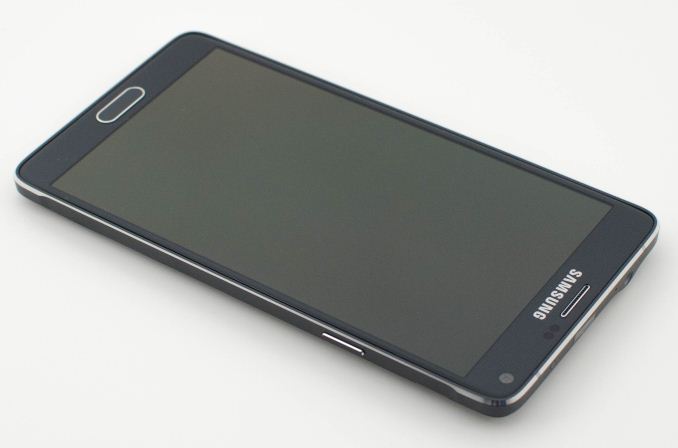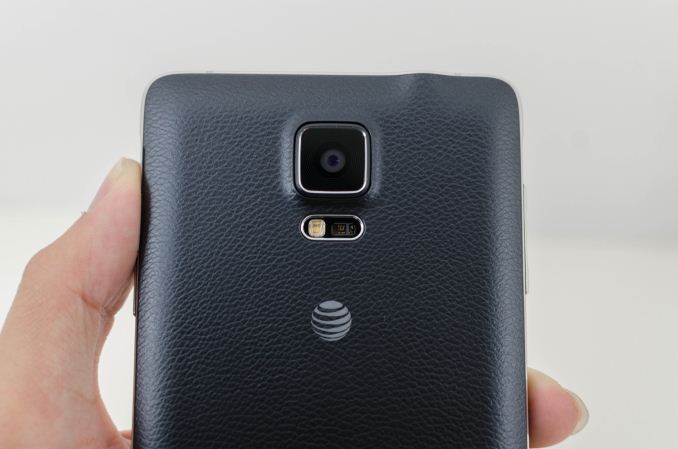The Samsung Galaxy Note 4 Review
by Joshua Ho on October 15, 2014 9:00 AM EST- Posted in
- Smartphones
- Samsung
- Android
- Mobile
- Galaxy Note 4
Final Words
The Galaxy Note 4 builds on the Galaxy S5 and Galaxy S5 LTE-A, but there’s still a lot to go over. We’ll break this down by section before coming to any real conclusions about this device. Based upon my time with the Galaxy Note 4, it’s clear to me that the most critical point of differentiation in the Galaxy Note 4 is the software experience. While other phones with TouchWiz can have similar features, it’s really a function of the hardware and additional feature support that comes with the Note 4 that makes the Galaxy Note more than just a big phone. The good news here is that Samsung continues to have a lot of great ideas in software, and many of the features tend to be quite helpful in nature. However, there’s a need to polish these features as the implementation tends to be rough around the edges. Overall, one shouldn’t have any significant issues with the software but Apple definitely has an edge in the polish department, even if the functionality isn’t as extensive.
The next key distinction is the display. The Galaxy Note is differentiated by its software, but defined by its display. It’s definitely big, and should be great for media consumption with its high contrast. More importantly, Samsung has continued to push better display calibration, brightness, and other areas where AMOLED was previously deficient. While there are still some issues with purple smearing and green tints to some level of grayscale, the AMOLED display is an equal to the 1080p display in the iPhone 6 Plus.
While the display defines the Galaxy Note 4 as a phablet, the design of the device itself is also important. To this end, Samsung has finally delivered a phone that feels as premium as its competition. While I do have some minor nitpicks regarding the design, on the whole it really is good enough that I don't have any real complaints. There are definitely phones and phablets out there that look and feel better, but the gap isn't large enough that it would count against the Note 4. The move to a unibody design would also mean that there wouldn't be a removable battery or microSD slot, which likely isn't worth the cost to Samsung in key markets like Korea that have a great need for both of those features.
While not quite as defining as the display, battery life is often one of the main draws of a larger phone. In this department, the Galaxy Note 4 does provide a level of improvement when compared to the Galaxy S5, but the higher resolution of the display means that battery life will slightly trail behind the iPhone 6 Plus. Despite this, no one should really have any issues getting a full day of use out of the Note 4. The adaptive fast charger also means that the Note 4 should be able to have better real-world battery life in scenarios where charge time is critical.
Finally, while unrelated to the formfactor itself, the Galaxy Note 4’s OIS has significant implications for low light performance and video quality. In practice Samsung’s OIS solution has a large accommodation angle and works well, although the use of OIS is closer to continuous rather in limited situations like on the iPhone 6 Plus. The use of OIS also makes it possible to go from the rather poor low light experience that we saw with the Galaxy S5 to a competitive one in the Note 4. While it isn't quite as good as the iPhone 6 Plus in low light, it makes up for it with higher resolution for daytime photography and similar situations where the 1.1 micron pixels aren't really a limitation.
We can talk more about the SoC performance, but at this point Snapdragon 805 is a known quantity. Instead, it's more important to talk about the Galaxy Note 4 as a whole, and on the whole Samsung continues to define the phablet segment with their features. For that alone, Samsung deserves praise as they continue to innovate in this space. If this innovation was also implemented with high levels of polish, I would have little issue calling the Galaxy Note 4 the best phablet on the market. As-is, the Galaxy Note 4 remains one of the best phablets on the market, but whether it's the best for a given user is a matter of priorities and personal preference rather than any absolutes.














195 Comments
View All Comments
JoshHo - Monday, October 27, 2014 - link
As noted in the review, the Note 4 doesn't use PDAF for continuous AF so that number isn't representative of the total "AF speed" as there's significant lag between recognizing that a scene is out of focus and the start of the focus run.Drumsticks - Wednesday, October 15, 2014 - link
It really amazes me (and is a testament to their engineers) that the A8 seems to deliver near twice the IPC/per clock performance as Krait.Also: good review in general! I think phablets are too big for me, but I like keeping up with where the market likes to go.
Calista - Wednesday, October 15, 2014 - link
Fully agree, the Apple A-series are amazing. Half the frequency, half the core count, one third the memory and still the fastest SOC more often than not while still being very frugal.danbob999 - Wednesday, October 15, 2014 - link
CPU benchmarks are not designed to test the benefit of having more RAM. One could design a benchmark using 2GB RAM. The iPhone would be slower than a Galaxy S3 because it would be swapping (or even failing).Javascript benchmarks test the browser more than the CPU. That's why the iPhone 5s still performs well in these benchmarks even tough it has a very slow CPU with no ARMv8.
mudman - Wednesday, October 15, 2014 - link
Wikipedia states that the a7 in iPhone 5s is based on armv8-a.kokono - Wednesday, October 15, 2014 - link
Does this mean iPhone6+ lags when compared to the new Galaxy?melgross - Wednesday, October 15, 2014 - link
Android needs more RAM to begin with. It's not a useful comparison.tipoo - Wednesday, October 15, 2014 - link
That's true, but not to the point of making 1GB on iOS moot vs 2-3GB Android phones. It definitely swaps apps out of memory more.KPOM - Wednesday, October 15, 2014 - link
How many phone apps really use more than 1gb right now? The iPad Air 2 will have 2 GB and my guess is that the iPhone 6s will too. But for now 1GB is fine.akdj - Thursday, October 30, 2014 - link
You're entirely TOO WRONG!Lol, what crap. I've got a Note 3, specifically for my business. The 5s as my personal, daily driver. I love em both for different reasons. Especially with what we do, the stylus on the Note for when we're doing it ...& collecting the pay for it with our clients using the SPen to sign their credit card receipt.
Other than that...nope. Nothing is 'better' on the S3, 4, 5 or Note 3 than the iPhone 5s. Display preferences aside, as an owner of both, for over a year can attest to their performance. It's ridicukius realily. My Note, again being a business line doesn't have a whole lot of apps other than productivity, a couple of 'creative' types and some excellent games to kill time on sites.
Any and EVERY app in 'parity' (available on both platforms) overwhelmingly plays more fluently on the iPhone. Productivity, cloud access and any type of 'creative' apps are abound, and they're excellent ...well optimized to a single, specific type ID hardware
It's amazing to me, in a stock cold boot of a Note 3 (I've reset a couple times), it's ALREADY using 19-2.1GB of RAM! The OEM and carrier crap is a silly joke
Apps come to iOS first. Are optimized for a single platform (& able to be played for years, fluently and with updates!). Crazy, a ⅓ the RAM, twice the processors at twice the clock speed is definitely the more 'usable' system. Customizing aside, I enjoy my home screen but for seconds ...it's the apps, their design UI and ability to 'run with reliability'. That's where iOS Smokes iOS. Secondarily, it's for a vertical & horizontal system, ala OS X.
Android has Chrome
The SPIII is a nice piece. If Windows gets ohine's figures out, Samsung's screwed.
Oh, sorry. They already are!
Then there's the tablets. Windows, again ..the SPIII is special
The Air2, incredible.
There's NOT a comparable tablet running Android. Nor will Chromebooks become anything other than a home appliance.
Sorry. You certainty don't understand RAM.